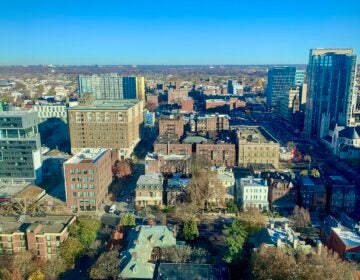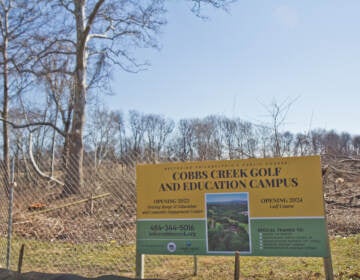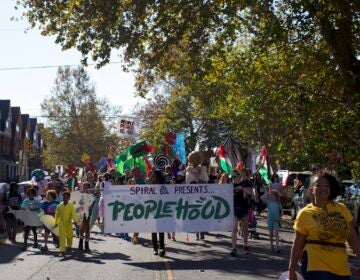Why Gen Z wants a place on 52nd Street — West Philly’s Black ‘Broadway’
Young people see a role for themselves on 52nd Street, especially after last week’s violent clashes between police and protesters and looters.
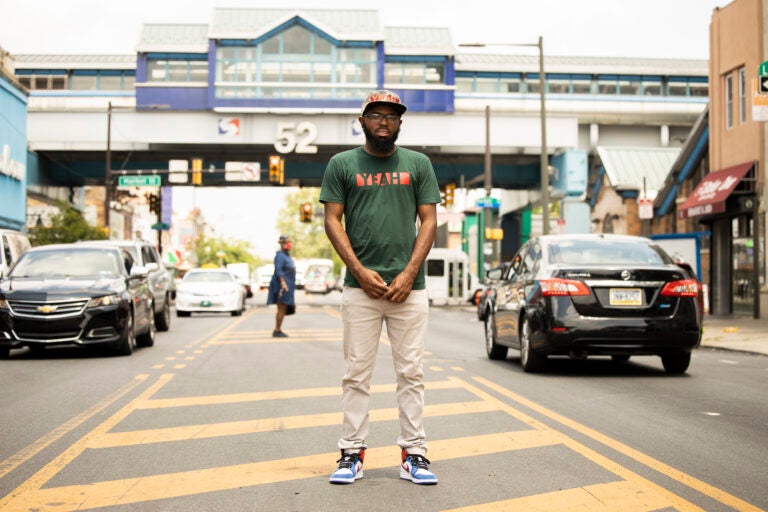
James Aye, a youth organizer, stands in the median on 52nd Street. (Ryan M. Collerd for PlanPhilly)
Kendra Van de Water and James Aye envision opening a brick-and-mortar space for youth on 52nd Street. The storefront would be a place to continue their work to empower and engage local youth — a mission that feels more relevant than ever in the wake of uprisings that rocked the street last week.
“We’ve been trying to get a space along 52nd Street because it’s a pinpoint spot,” says Aye, referring to the Philadelphia Police Department’s Operation Pinpoint, an initiative to identify crime hotspots. “If you don’t want it to be a pinpoint area, you need to give kids an outlet … we actually go into the community and find kids and take them in along 52nd and 60th.”
Van de Water and Aye are the cofounders of YEAH Inc., a nonprofit community organization that stands for Youth Empowerment for Advancement Hangout. Since 2019, they’ve worked with West and Southwest Philadelphia teens who have been affected by violence. Their goal is to challenge the status quo through teen action.
For now, YEAH operates out of a number of different local facilities including Cobbs Creek Recreation Center near 63rd and Market and Myers Rec at 58th and Kingsessing. The same stretch of 52nd Street where YEAH hopes to make a permanent home was, last Sunday, the focus of intense unrest in response to the death of George Floyd and the systemic injustice behind the deaths of so many other Black Americans at the hands of the police. Many young people participated in the action, which made national news in stories that centered around looting and property damage.
The event culminated when police deployed a thick fog of tear gas that wafted into neighboring homes. Officers shot rubber bullets at protestors as they attempted to clear the block. Footage of the chaos spread widely across social media.
Much of the property damage and looting affected police property and larger corporate stores like Foot Locker and ShopRite, but several smaller Black-owned businesses were also damaged. Many of them were already suffering from a lack of business and financial support through the pandemic, and some don’t have insurance to help cover costs.
Neighbors worry that the damage may be insurmountable. May have expressed frustration over the gutting of stores they, and many elderly community members, rely on for food and medicine.
But beyond the physical damage to the corridor, there’s been a wider recognition that some community healing needs to take place, in particular, a rift between the older and younger generations. Some of the teens Aye and Van de Water work with at YEAH were involved in the protest and looting on Sunday, but the bigger issue, they say, is a lack of engagement and resources for young people in the area in general.
“Places aren’t willing to put in the extra resources to support the type of young people that we work with,” said Van de Water, who also lives in the neighborhood. “They feel unheard and they feel isolated.”
YEAH’s goal is to provide a space for teens that feels like their own and, in the process, helps them feel included and supported within the larger community, something that, in Van de Water and Aye’s, minds isn’t well achieved through existing youth programs. Youth programs offered through schools, libraries, and rec centers often have too many rules and the structure can make teens — especially those dealing with trauma around poverty or violence — retreat rather than engage.
Providing youth space, they feel, is critical to establishing better relationships between young people and the business owners along the corridor. “When you have space like a community space for young people along the business corridors, that kind of helps build the relationships with those businesses,” said Aye.
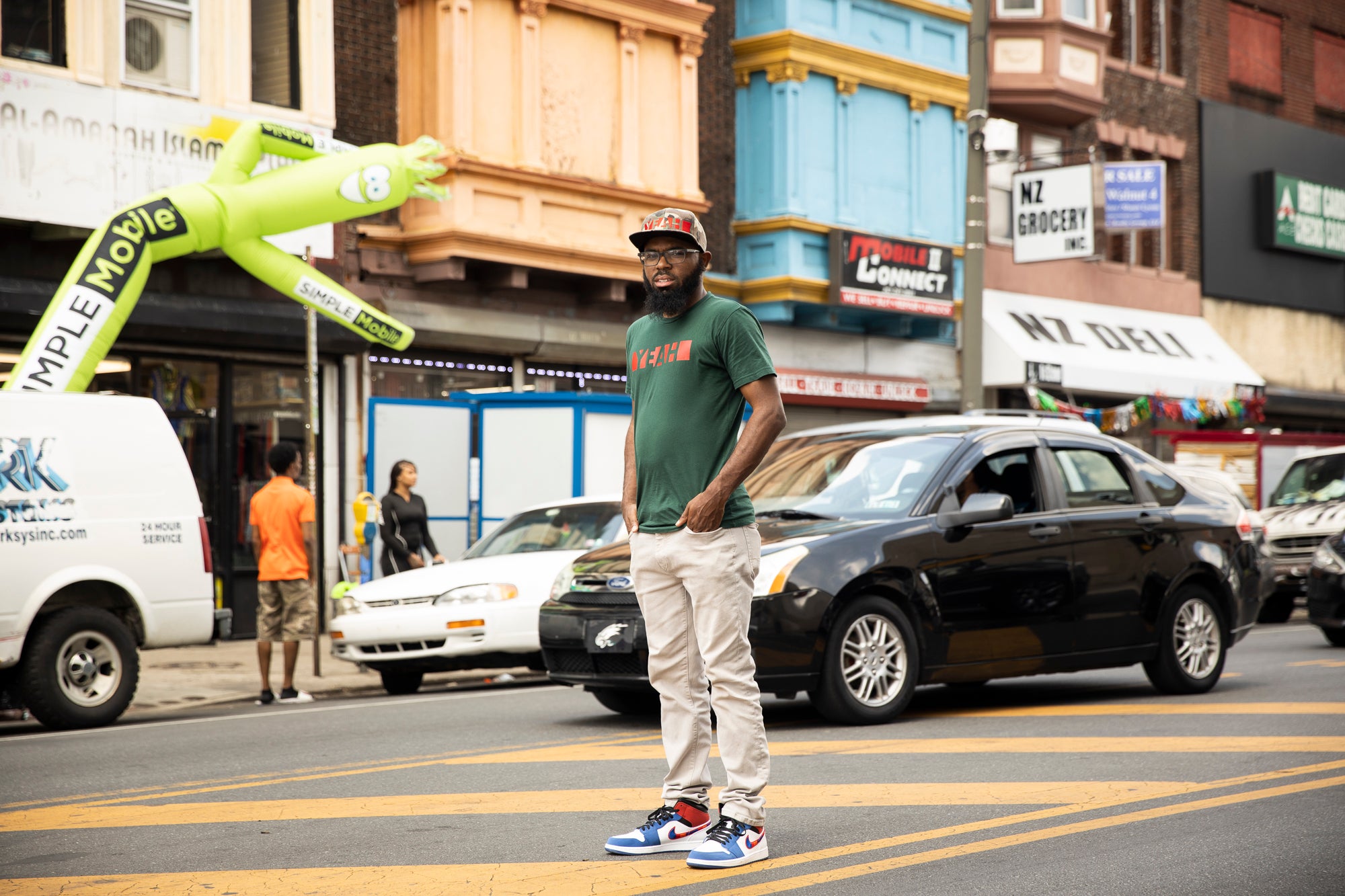
Fears of gentrification on ‘the strip’
Renee McBride-Williams remembers how glamorous it felt to walk down 52nd Street when she was a child. “The men were dapper, women wore high heels, silk, and satin … I remember thinking, ‘I want to look like that when I get older.’”
Known as “the Strip,” the stretch of 52nd Street between Market Street and Baltimore Avenue was once a lively center for arts and culture in a robust Black community, home to five movie theaters and famous jazz clubs like the Aqua Lounge and Red Rooster. McBride-Williams, who serves as President of Cedar Park Neighbors, recalls how the street was lined with neon signs, “It looked like you were going down Broadway in New York … People didn’t want to break the glass, they were just excited to be a part of the action.”
But over the decades the corridor has evolved, weathering disinvestment, delayed infrastructure projects, and now gentrification, slow but insidious strains that are fueled by the same systemic racism that has brought out millions in protest across the country.
52nd Street is still home to many small, Black-owned businesses, but corporate chains have also made their way in. And though it’s nowhere near its heyday of the ‘60s and ‘70s, there remains a cultural presence through legacy businesses like Hakim’s Philadelphia Bookstore and the Bushfire Theater, and more recent additions, like Urban Art Gallery. While there’s still a lot of community history there, some feel that the younger generations aren’t being supported in engaging with the community as they could be.
McBride-Williams says kids today feel left out of the school system, feel disconnected and alienated based on their experiences with poverty, and that “they don’t see a lot of hope in this space.”
“There’s not a lot [there] that brings hope or entertainment to the kids,” McBride-Williams said, referring to 52nd Street. “Today, they’re looking for more, they’re looking for something they can contribute to … without police presence, without being chased out.”
There’s been some effort made to engage youth in the past, sometimes through long-standing businesses like Hakim’s Philadelphia Bookstore, which offers internships and workshops oriented around entrepreneurship and marketing aimed at young people between the ages of 19-30. But, as Aye points out, there’s not much for kids and younger adults to do after stores close.
Aye is also concerned about the inherent conflict posed by developing 52nd as a business corridor and the resulting gentrification. How can young people be involved in creating a dedicated space to express themselves if rents continue to rise, he wonders. Already, real estate prices along the corridor are becoming too steep for small grassroots organizations like theirs.
The threats of gentrification and displacement are concerns that members of the community have long been struggling with. The area has numerous amenities that make it an attractive target for development and revitalization: access to trolley and subway lines, a shared border with Malcolm X Park, and proximity to universities.
“The goal is to spark revitalization in a way that is very mindful and respectful of longtime businesses and community members,” said Jesse Blitztein, who serves as the Director of Community Development at the Enterprise Center, which works explicitly to support minority-owned businesses. “I think the key question is, how do you successfully balance old and new to the mutual benefit of everyone?”
A donation fund set up by the Enterprise Center, which also helped organize a community cleanup the next morning, received an outpouring of support that has been “nothing short of amazing,” said Blitztein. The Center plans to distribute a first round of funds to impacted small businesses as quickly as possible.
‘A space to come together’
Councilmember Jamie Gauthier is sympathetic to the experiences of both generations, and to the threats posed by potential speculation along the corridor.
“52nd Street has been hit with a triple whammy between COVID, the depression caused by COVID, and now by civil unrest,” Gauthier said. “If we want to preserve the culture and identity of 52nd Street as a center of Black culture and commerce we have to start planning now before that speculation starts,” she said. “What we can lose if we don’t is really great.”
Gauthier, a mother who grew up in the neighborhood and is raising her two sons there, made headlines last week when she called Mayor Kenney from the street while people around her clashed with police and asked him to listen to the young voices.
On Sunday, her office quickly held a “Virtual Listening Session” with youth activists, State Representative Joanna McClinton, and members of PPD leadership. The listening session, in-person meeting that ran nearly three hours long, was streamed live via Councilmember Gauthier’s Facebook page.
“I think overall the meeting went as good as it can,” said Tamir Harper, a rising junior at American University, who grew up in the area and attended the listening session. “Communities are still in trauma, communities are still in rage, communities are still in grief.”
Harper is the co-founder UrbEd Inc., a nonprofit that advocates for quality urban education. “I think it’s always challenging when you have a mix of age groups together,” he said of the gap between generational perspectives, “I’m Generation Z and I think Gen Z has been very clear that we will not allow our children to continue to march and yell against police brutality.”
Harper sees the protests as a critical part of a fight for the future he and his peers envision. Implicit in their outlook is the systemic nature of interrelated issues like racism, policing, education, and gentrification.
“When we are thinking about what community looks like, we are pushing the heart and soul out of West Philly, and the 52nd Street neighborhood out of that community,” Harper said. “So, when we are talking about Black lives and when we’re yelling ‘Black Lives Matter’ and we yell ‘No justice no peace!’ we’re talking about Black schools … we’re talking about Black housing.”
And Gauthier, for one, is listening.
“Those young people. I am blown away by how brilliant and how clear they are,” the councilmember said.
Van de Water and Aye say the takeaway for them will be “accountability.”
“At some point there needs to be accountability when it comes to sustainable action, what it looks like, and how the community needs to be represented,” said Van de Water.
And where that can happen — whether on 52nd Street or elsewhere — matters too, said Harper.
“It’s 100% necessary in all spaces throughout the community that we have young people at the table, as well as give them spaces for them to come together.”
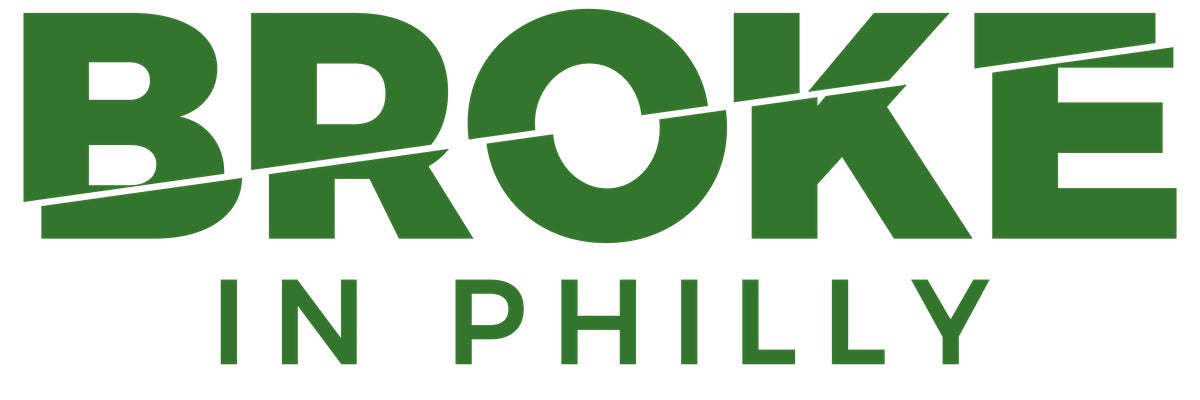 WHYY is one of over 20 news organizations producing Broke in Philly, a collaborative reporting project on solutions to poverty and the city’s push towards economic justice. Follow us at @BrokeInPhilly.
WHYY is one of over 20 news organizations producing Broke in Philly, a collaborative reporting project on solutions to poverty and the city’s push towards economic justice. Follow us at @BrokeInPhilly.

Subscribe to PlanPhilly
WHYY is your source for fact-based, in-depth journalism and information. As a nonprofit organization, we rely on financial support from readers like you. Please give today.





